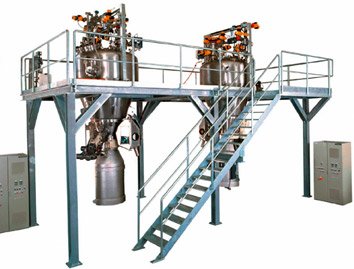During AstraZeneca’s development of a new API, several conventional techniques for isolating and drying the compound proved to be inefficient. In order to achieve better production rates on a manufacturing scale, it was decided to combine a horizontal, pharmaceutical-type peeler centrifuge with a mixer dryer from Krauss-Maffei Process Technology.
The aim was to improve the capability to produce a new drug at AstraZeneca’s Avlon site in the UK. A major part of this work involved selecting machinery and plant for filtration and drying.
Gathering information
To begin with, the only information available on the product properties was that it was „difficult to filter“. As regards the solids concentration in the suspension, all known data was founded on laboratory results and scanning electron microscope shots of the crystals.
A detailed schedule was drawn up and data was acquired about the behaviour of the product prior to preparing a product plan on the basis of a batch process. Using these findings, test apparatus was selected and a pilot plan was prepared.
The evaluated filtering equipment consisted of Nutsch filters, HZ Ph horizontal peeler centrifuges, horizontal inverting bag centrifuges, belt filters, and rotary vacuum and pressure filters. The assessed dryers were pan dryers, spherical dryers, paddle dryers, conical dryers, double cone dryers and fluid bed dryers. Centrifuge fluid bed dryers, centrifuge convection dryers, spray dryers and flash dryers were tested as combined processes. The filtration systems were evaluated according to the following criteria:
- Compression of the filter cake
- Throughput
- Sensitivity of the crystal structure (grain fracture)
- Cleanability and use of several wash liquids
- Leak-tightness
- GMP conformity
- Ease of removing residual heel
The drying equipment was additionally evaluated on the basis of efficiency, water or solvent drying and caking behaviour. After evaluating this information, tests were carried out using the following equipment:
- Pharmaceutical-type horizontal peeler centrifuge
- Horizontal inverting bag centrifuge
- Combined centrifuge and fluid bed dryer
Results
The most efficient separating apparatus was found to be the combination of a centrifuge and a fluid bed dryer. The equipment chosen was a pharmaceutical-type HZ Ph horizontal peeler centrifuge interacting with a mixer dryer from Krauss-Maffei Process Technology. With characteristics such as full inspectability, minimal dead zones and optimum cleanability, the HZ Ph meets today’s state-of-the-art requirements for modern production of pharmaceutical products and fine chemicals. An additional feature of the recently improved centrifuge is its compact design. This has facilitated a reduction in the volume of the process area and the surface in contact with the product.
Major improvements have also been made to the product discharge. Even extremely adhesive or thixotropic products can be peeled off, leaving practically no deposits. This clearly broadens the application spectrum for pharmaceutical-type horizontal peeler centrifuges. Contactless level measurements are carried out using ultrasound. Even frequent changes of solvent no longer represent a problem.
Advantages of the mixer dryer
The mixer dryer from Krauss-Maffei Process Technology is used whenever sensitive or expensive products have to undergo gentle drying. The dryer can be operated at atmospheric pressure, in a vacuum or under pressure. The drying stock is taken in by a vertically arranged vessel. Mixing is carried out by a mixer with a special screw which rotates about its own axis and is moved in a reversing action along the vessel wall.
The temperature of the vessel wall and the mixing screw can be controlled to facilitate heat exchange. Owing to the vacuum-tight design of the vessel, it is possible to opti-mally exploit all the advantages of gentle-action vacuum drying at low temperatures with a high degree of efficiency.
The key advantages of this mixer dryer are:
- Product discharge with no product loss due to the conical shape of the vessel, as well as reliable solids discharge via a special, highly efficient discharge valve
- Uncomplicated installation (also in clean rooms) thanks to the absolute separation of the process and drive parts
- Fast and flexible drying by means of intensive heat exchange resulting from both the vessel heating and the heating of the mixing screw; direct measurement and monitoring of the product temperature
Installation of the plant
The whole plant extends over four storeys. The solids are conveyed inside the plant by gravity. The centrifuges and the dryers are installed in a clean room. Fully automatic CIP (cleaning in place) units are installed for easy cleaning and validation of individual batches.
The process part of the centrifuge is separated from the drive part by the clean room wall. This means that all mechanical parts are located outside the clean room. The product discharges without clogging as a result of the optimised geometry of the discharge equipment. Automatic removal of residual heel ensures a high product yield.
The dewatered product is conveyed into the mixer dryer by gravity. Vapour condensation and product caking are avoided due to the gentle and controllable heat input. The final outcome of the drying process is a non-clogging, free-flowing end product that is ready for further processing or storage in barrels.
To minimise costly detail engineering, the drying plant has a modular design. The client thus receives pre-assembled and tested modules that are assembled on site like building blocks. The advantages of this are not only that expensive detail engineering is no longer necessary, but also that potential error sources are eliminated by the manufacturer’s FAT (Factory Acceptance Test) and assembly times in the field are reduced to a minimum.
The commissioning parameters were initially selected on the basis of scale-up tests. A more „gentle“ selection process proved necessary following the completion of the first test. The ideal parameters for operating the plant were then defined in the subsequent tests.
cpp 432
Share:







